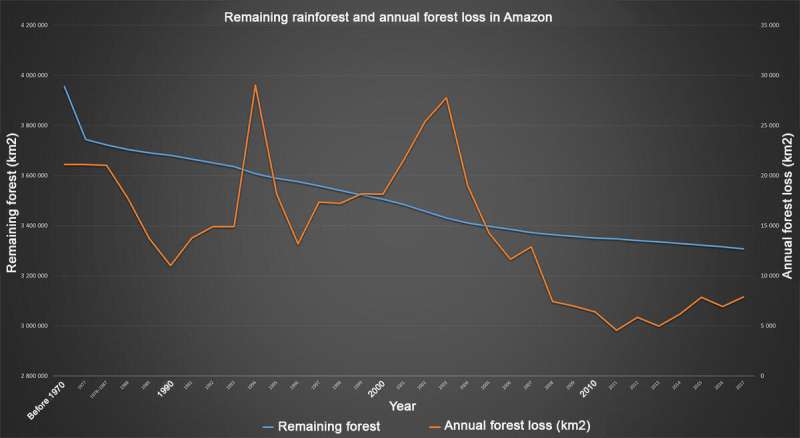Amazon: On the edge of the burnt rainforest

The flames have been smothered in the lush rainforest, but the impacts of the degradation are likely to last.
The fate of the plants, animals and habitats on the edges of Amazonia remains as yet uncertain, but investigations are being carried out by a project funded by the Academy of Finland and headed by Academy Research Fellow Eduardo Maeda, a native of Brazil, at the University of Helsinki, with the aim of finding increasingly effective conservation methods.
The question is topical, as slash-and-burn clearing is fragmenting the Amazon rainforest into smaller and smaller plots. Human activity impacts forests all across the globe—as much as 70 percent of the world's forests are considered fringe areas due to their proximity to settlements, arable land or roads.
A changing microclimate
In spring 2019 Maeda visited the longest running fragmentation experiment in the tropics, located in the middle of Amazonia. He used Laser scanning methods to create very detailed 3-D models of the forest. The data will be used to study how degradation changes the forest environment close to the edges.
Postdoctoral Researcher Matheus Nunes is currently in Brazil collecting repeated Laser scanning measurements, every 15 days, to see how forest fragmentation affects the dynamics of the forest (eg. tree growth, leaf production, etc).
The data accrued over a five-year monitoring period will be used to model changes in the forest structure.
In addition, Maeda and his team have installed microclimate sensors resembling the destroying angel mushroom. The sensors measure temperature and humidity, and will provide a long term perspective on how changes in the forest structure are related to microclimate changes in the edge of fragments.
The researchers have found that, in spite of trees and bushes growing rapidly, the impacts of edge effects are long lasting, as the water cycle typical of rainforests has stalled. The researchers are interested in changes to the habitats of the fringe areas and related effects on biodiversity, as well as, indirectly, on climate change.
Their aim is to determine the means best suited to protecting the diminishing and fragmenting forest. At the moment it is not known how biodiversity in the fringes is being affected.
Clear-cut areas predict burning
The fate of the tropical rainforest is a cause for particular concern, as the Amazon jungle is a unique carbon reservoir and hosts the most diverse biome on the planet.
In Brazil, deforestation follows a well-known pattern. First trees needs to be put down with the help of tractors, and then they are left to dry out during the dry season. Only then they can be burned. This practice has been going on for decades.
"Satellite images have alerted about the first stages of this process already months ago, but unfortunately no action was taken to prevent the burning of the trees," Maeda says.
The recent fires have initially gained international attention due to the clouds of smoke reaching Brazil's largest city, São Paulo .
Another cause for concern is the indifference of the current administration, which has only been compelled to take action thanks to the prospect of international economic sanctions. Currently, a temporary burning ban is in effect. However, most of the damage has already been done.
According to Maeda, increasing consumer awareness and environmental consciousness can bring about economic pressure, which may help change how local farmers manage their activities.
Provided by University of Helsinki




















